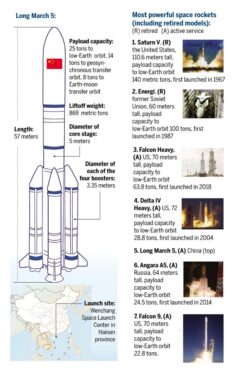“METEOR spotted in Kuching! #jalanbako 31/7/2022,” reads a Twitter post alongside a videography by Nazri Sulaiman at 12.57am this morning (July 31). “Sorry it’s not meteor. It’s the rocket. My bad (pics on the left).”
Nazri’s post which has since generated 1.5 million views and almost 6,000 retweets at the time of writing could be that of China’s 25-tonne core stage of a Long March 5B rocket that re-entered Earth’s atmosphere over the Indian Ocean, thus ending its brief but controversial orbital stay.
“#USSPACECOM can confirm the People’s Republic of China (PRC) Long March 5B (CZ-5B) re-entered over the Indian Ocean at approx 10:45 am MDT (12:45pm EDT; 1645 GMT) on July 30,” the US Space Command announced via Twitter today.
“We refer you to the #PRC for further details on the re-entry’s technical aspects such as potential debris dispersal + impact location.”

Lifted off on July 24, the Long March 5B carried a new module toward China’s under-construction Tiangong space station.
“The video from Kuching implies it was high in the atmosphere at that time – any debris would land hundreds of km further along track near Sibu, Bintulu or even Brunei,” tweeted astrophysicist and satellite tracker Jonathan McDowell of the Harvard-Smithsonian Centre for Astrophysics.
“It’s ‘unlikely but not impossible’ that one or more chunks hit a population centre,” added McDowell in another tweet.
Unlike the core stages of most rockets which are steered to a safe disposal shortly after launch or land softly for future re-use, the Long March 5B reached orbit along with its payload.
And it stayed up – as a big, fast-moving piece of space junk – until atmospheric drag brought it down in an unpredictable and uncontrolled fashion, according to Space.com senior writer Mike Wall.
“Mission managers didn’t screw anything up; this end-of-life scenario is built into the Long March 5B’s design to the consternation of exploration advocates and much of the broader spaceflight community,” he further revealed.
“This disposal strategy is reckless, critics say, given that the big rocket doesn’t burn up completely upon re-entry.”
For their part, Chinese space officials noted that the rocket body re-entered at 119.0 degrees east longitude and 9.1 degrees north latitude. That location, according to Wall, is over open ocean – just off the coast of Palawan Island which is part of the Philippines.
“We’ll have to wait a while to see exactly where the rocket debris came down. But the fact that the crash occurred at all does not reflect well on China and its spaceflight programme,” added Wall. – July 31, 2022









